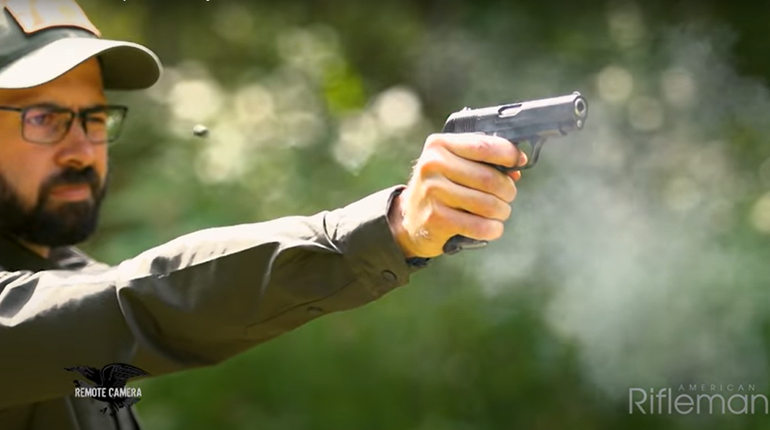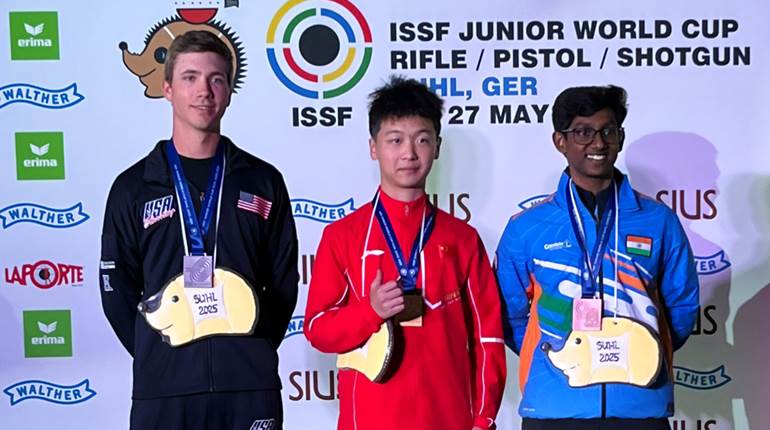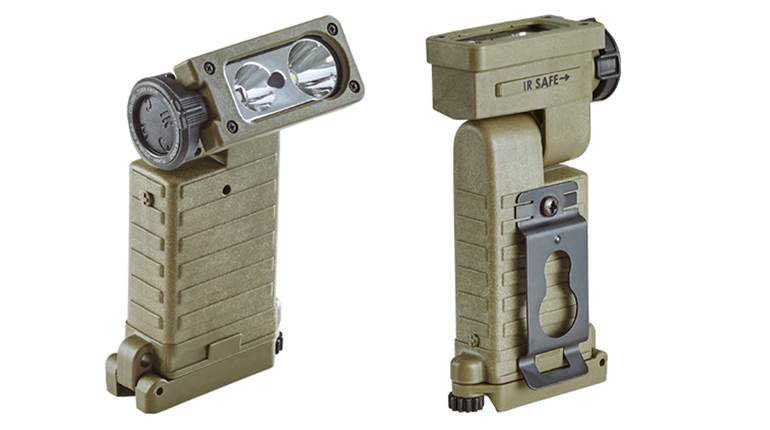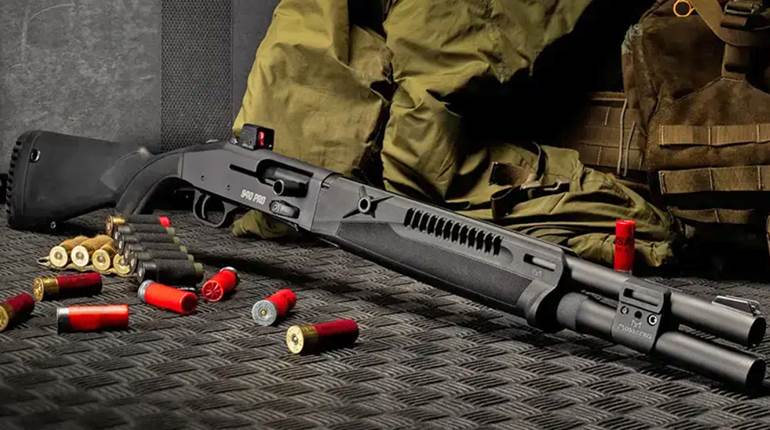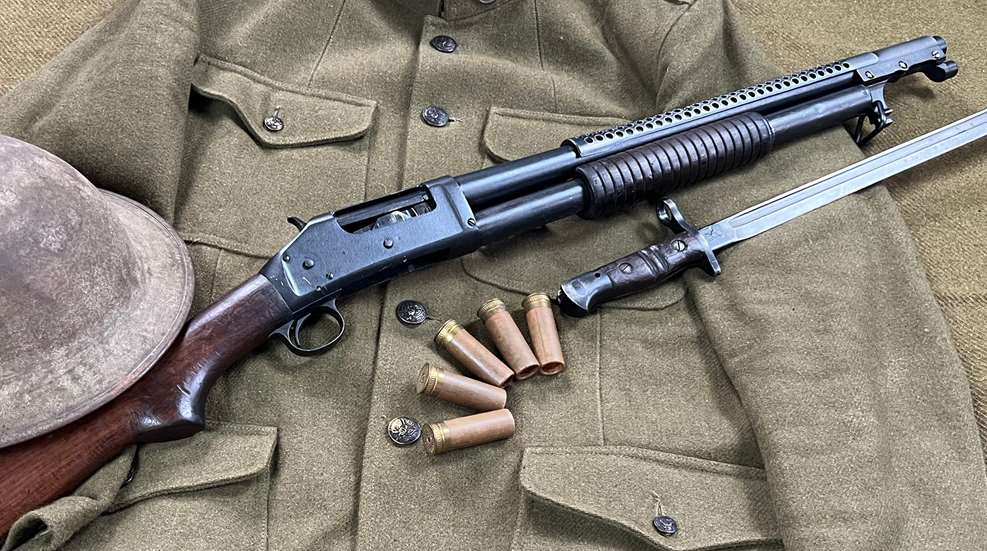
During the First World War, the Winchester M1897, fitted with the M1917 bayonet, (colloquially called the “trench gun” by collectors) became perhaps the most iconic and immediately recognizable American small arm of the conflict. It is unusual, it is intimidating and from the very start was surrounded by misconceptions, myth and mystique. The popular narrative generally lays out a linear tale of an initial general fielding to the American Expeditionary Force (AEF), a panicked and plaintive German complaint in response to the brutal battlefield efficiency of the shotgun, and a cry to “send more shotguns!” from the Doughboys who were enamored with the tool. As with most history, there is much more to the story.
This article seeks to determine what actually went on “over there” with bayonet-tipped shotguns by using official military documentation from the AEF, Ordnance Dept. and State Dept. When comparing those sources against both newspapers and magazines of that era, and today’s popular beliefs about World War I shotguns, it reveals some glaring discrepancies. Specifically, this article will delve into the proper nomenclature of bayonet-equipped shotguns, the actual procurement and use of shotguns by the AEF overseas, the role that sensational journalism has played in the story and also take a closer look at the German protest.
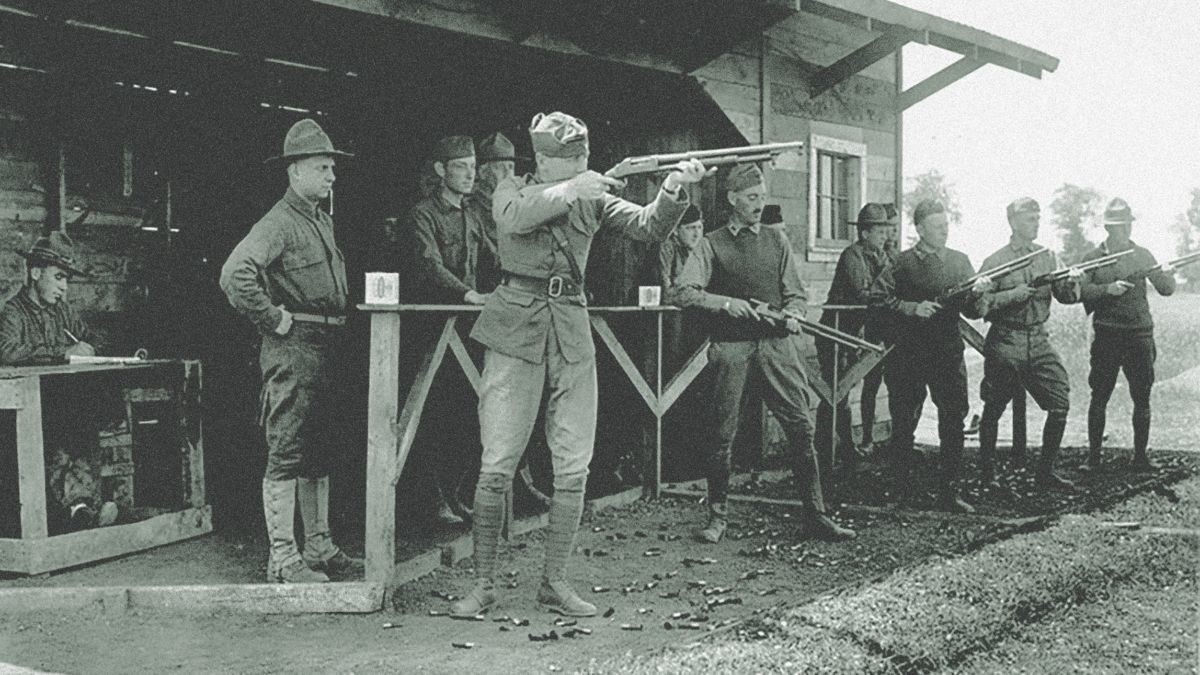 One of the few, if not the only, picture of a "trench gun" in use overseas during World War I—in this case being used on a firing line for either training or recreation alongside other shotguns not capable of mounting bayonets.
One of the few, if not the only, picture of a "trench gun" in use overseas during World War I—in this case being used on a firing line for either training or recreation alongside other shotguns not capable of mounting bayonets.
There is no doubt about the brutal combat effectiveness of shotguns in certain combat situations, or the brave men of the AEF who fought in the Great War. But it is time to illuminate the divide between military fact and firearm collector lore when it comes to World War I shotguns.
Terminology
A pressing issue to address early is that of official terminology. Although it has become the primary way of referring to any bayonet-capable shotgun, the term "trench gun" or “trench shotgun” was never an official U.S. military term. Instead, it appears to be largely a handy collector phrase born from the sensational news coverage of the era, as well as informal “soldier-talk” during and after the war. During World War I, these guns were never given a formal "United States Model of" designation. Official period primary sources instead used the following designations to refer to a shotgun with a heat shield fitted for a bayonet:
- Riot Gun with Bayonet Adapter
- Riot Gun
- Repeating Shotgun
- Automatic Shotgun
The Ordnance Dept. and AEF correspondence used these designations in a generally interchangeable manner, and as there was no set standard, it can become quite confusing. The most common designation for shotguns fitted with bayonet mounts and heat shields appears to be "riot gun with bayonet adapter," and although it is a somewhat long designation, it is also the most precise. Therefore, in an attempt to hold closely to the primary sources, and the intended usage of the firearm itself, the term “riot gun with bayonet adapter” will be used throughout this article.
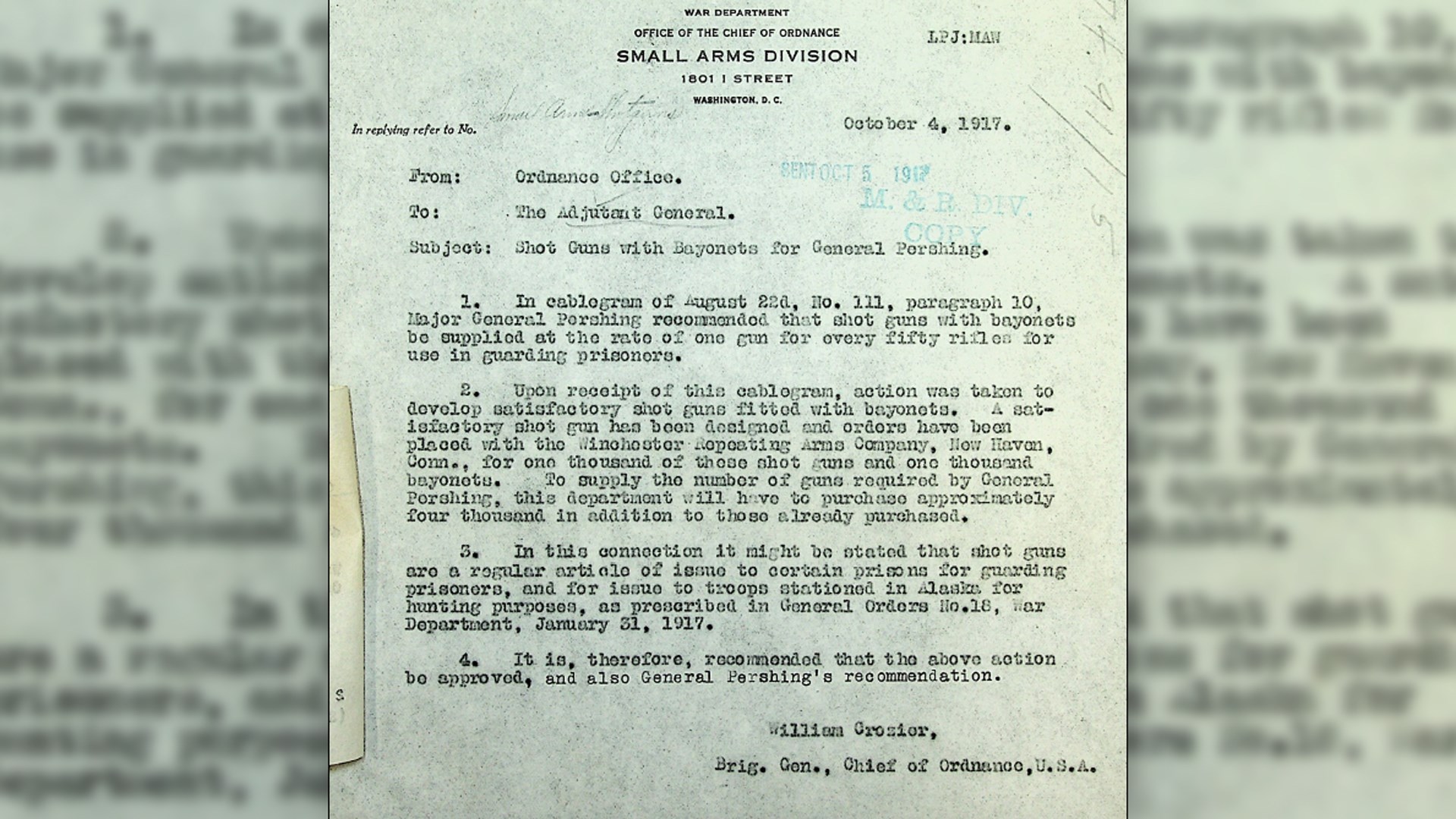 Brigadier General Crozier, the Army's chief of ordnance, references Gen. Pershing's request for bayonet-capable shotguns for use in guarding prisoners and reports on their efforts to develop a suitable gun. He also notes previous military use of shotguns for special purposes. Document courtesy of Archival Research Group.
Brigadier General Crozier, the Army's chief of ordnance, references Gen. Pershing's request for bayonet-capable shotguns for use in guarding prisoners and reports on their efforts to develop a suitable gun. He also notes previous military use of shotguns for special purposes. Document courtesy of Archival Research Group.
After reviewing numerous pages of World War I-era shotgun-related documents from the AEF and Ordnance dept., the term “trench gun” was found only twice—in documents from 1921 and 1922. The documents are successive Infantry Board reports concerning the waterproofing of paper shotgun shells, which describe the test platform as a “Winchester Model 1897 ‘trench’ or riot gun.” While this indicates that “trench gun” was indeed in some colloquial usage, it was at best an informal turn-of-phrase worthy of qualifying quotation marks.
Even if one jumps forward to World War II, the term “trench” appears exactly once in the 1942 Technical Manual for “Shotguns, All Types”—where the manual describes digging ditches to divert water from ammunition stored in the open. Even in World War II, these were simply called M97 “riot-type guns,” and no formal model differentiation was made between those with or without bayonet adapters and heat shields, indicating that “trench gun” had not caught on in any official sense—despite some 20+ years in service.
Shotguns In France: Why, When & The Result
Even though Americans did not start the war wielding bayonet-capable shotguns, shotguns of other types had previously been in limited use with the 20th-century American Army. However, while commercial-pattern Winchester 1897s did see combat use in the Philippines during the early 1900s, shotguns were a regular article of issue for only two purposes: guarding prisoners and hunting (which was a necessary military endeavor at some isolated posts in Alaska and the Philippines). When, in 1915, a lieutenant from the 6th Cavalry requested to purchase two Winchester repeating shotguns for use by camp guards for driving off Mexican bandits, he was denied by the office of the chief of ordnance since his proposed use did not fall under either authorized situation.
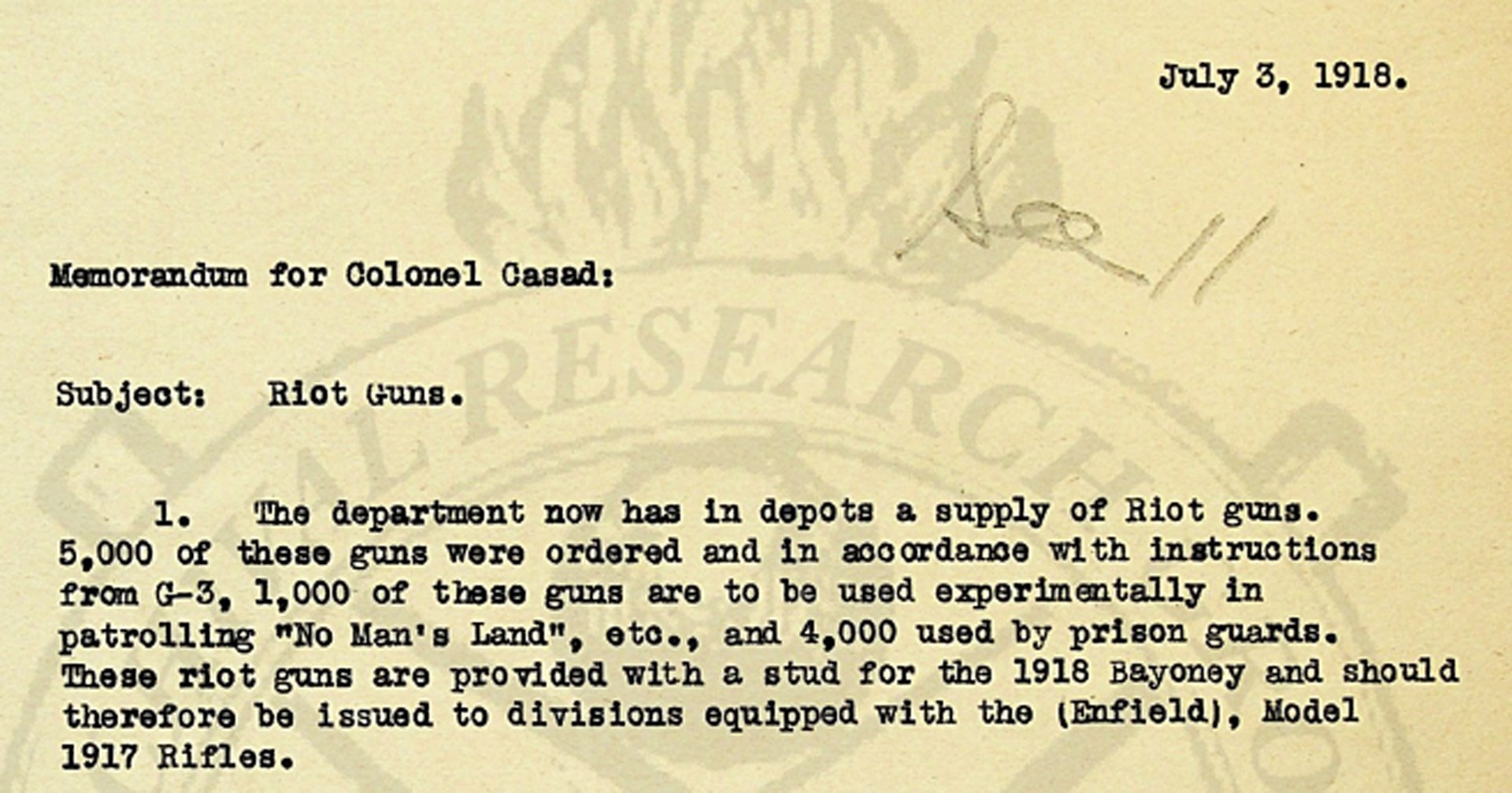 Of the initial 5,000 riot shotguns with bayonet adapters set up for use in the AEF, 80 percent were for use in guarding prisoners while the remaining 20 percent were destined for combat field trials. When this memo was written, the first shotguns were being issued to divisions for those tests. Document courtesy of Archival Research Group.
Of the initial 5,000 riot shotguns with bayonet adapters set up for use in the AEF, 80 percent were for use in guarding prisoners while the remaining 20 percent were destined for combat field trials. When this memo was written, the first shotguns were being issued to divisions for those tests. Document courtesy of Archival Research Group.
After the 1917 arrival of U.S. forces in Europe, however, the need for a riot gun with bayonet adapter was recognized relatively quickly. As recounted by the Chief of Ordnance Brig. Gen. William Crozier, in an Aug. 22, 1917, telegram, Gen. Pershing recommended the adoption of shotguns at “the rate of one gun for every fifty rifles for use in guarding prisoners.” Accordingly, the chief ordnance officer of the AEF noted that by Nov. 24, 1917, “Five thousand shotguns with bayonets have been ordered from the United States, deliveries to begin in December, 1917.”
The Primary Procurement Purpose: Prisoners
While there appears to be some confusion between stateside and AEF sources on exactly how many were ordered and when, one thing is crystal clear between them: the primary purpose for which shotguns were desired by the AEF. Multiple well-positioned sources clearly and unequivocally explain that these shotguns are being obtained for guarding prisoners and other rear areas, something which would be of great importance following the expected transition to “open warfare” and a dramatic push towards Germany itself.
Besides Pershing’s telegram requesting them for use in guarding prisoners, other sources echoed this same refrain from the very beginning. Colonel (later Brig. Gen.) Fox Conner, the AEF’s assistant chief of staff for operations (G-3) recommended in December 1917 that of the 5,000 shotguns fitted for bayonets, “1,000 of them be retained for issue to troops for experimental purposes after organizations have been put into the line […] the remainder to be utilized in guarding prisoners or such other work on the line of communications as may seem desirable.”
As a direct member of Gen. Pershing’s headquarter staff, Fox Conner was in close proximity to the AEF commander on a regular basis, and given his position in the G-3, his suggestions and directions would generally reflect the intent of Pershing himself. And indeed, his suggestion was apparently taken to heart since in July 1918. On the cusp of those trials and after sufficient numbers of shotguns had arrived, the office of the chief ordnance officer of the AEF indicated that 4,000 shotguns were to be used by prison guards, while “1,000 of these guns are to be used experimentally in patrolling ‘No Man’s Land’, etc …” citing the instruction of the G-3.
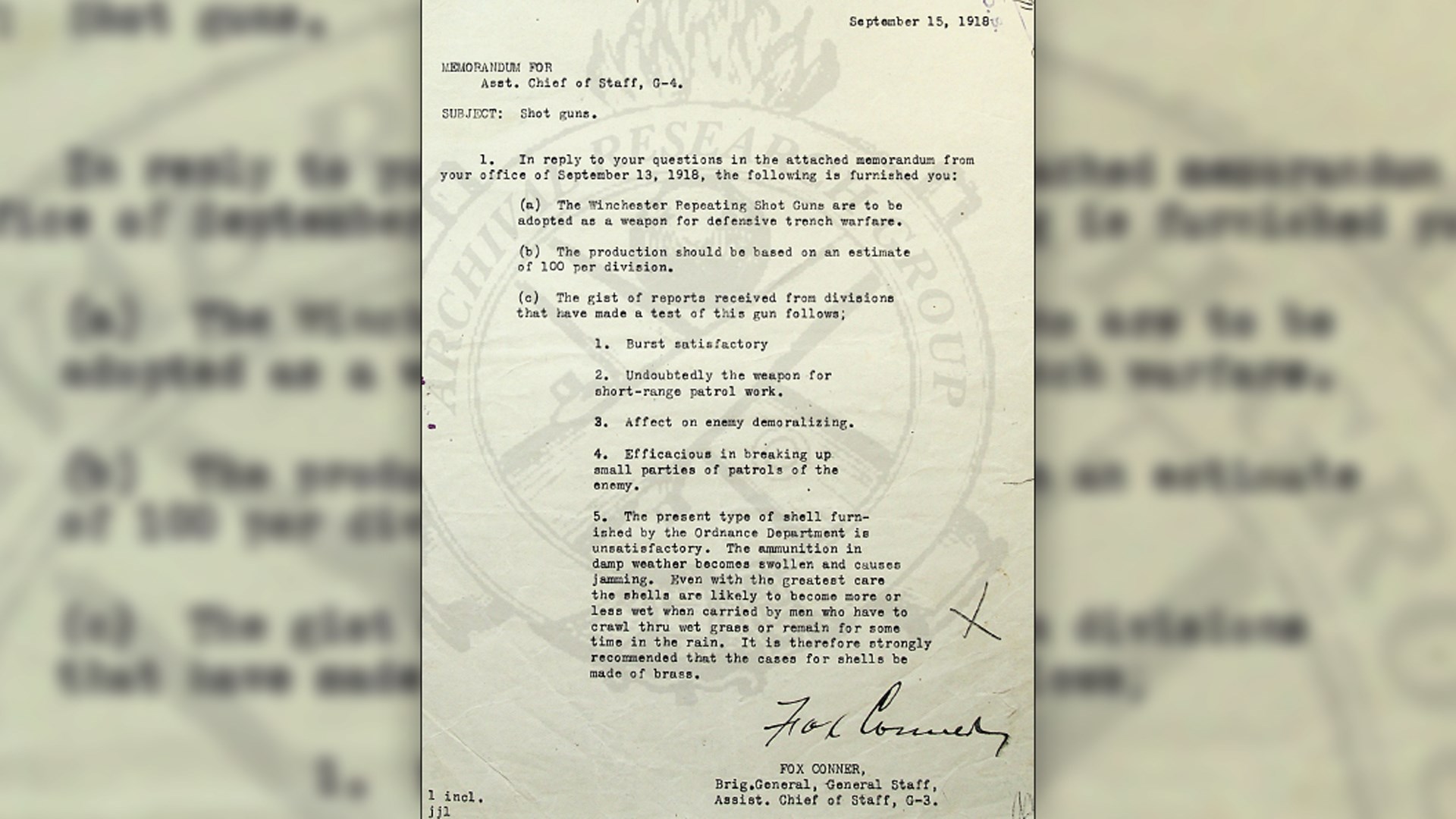 Brigadier General Fox Conner, the assistant chief of staff for operations (G-3) was overall pleased by the shotgun field trials and recommended their adoption for defensive trench warfare, despite the issues he noted with the paper shells. He recommended that 100 be issued per 28,000-man infantry division. Document courtesy of Archival Research Group.
Brigadier General Fox Conner, the assistant chief of staff for operations (G-3) was overall pleased by the shotgun field trials and recommended their adoption for defensive trench warfare, despite the issues he noted with the paper shells. He recommended that 100 be issued per 28,000-man infantry division. Document courtesy of Archival Research Group.
One example, besides prisoner guarding, of where shotguns were both desired and practical was in protecting the huge amounts of war materiel accumulated to support the ever-growing AEF. Reports through quartermaster channels indicated that French civilians were poking around supply depots, possibly to “take desperate chances to break into storehouses and carry off government property,” requiring sentries to fire warning shots to drive them off.
Due to the “thickly populated” neighborhood among other warehouses and railroad tracks, and the repeated break-ins, at least one general officer requested the Ordnance Dept. to furnish “fifty riot shotguns with ammunition for the guarding of this warehouse and similar places.” These were necessary as “Automatic pistols in the hands of green men will be about as dangerous to the neighborhood as service rifles [and] the accidental killing of some innocent person in the neighborhood would result in an awful clamor from the French people.”
While perhaps out of the loop being stateside, Maj. Julian Hatcher, in correspondence from late September 1918, stated that “These guns were bought for the purpose of guarding prisoners. The Ordnance Dept. is not officially advised that they have been used, or will be used, for any other purpose.”
A Secondary Purpose: Combat Field Tests
Before bayonet-capable shotguns arrived overseas, a plan was concocted to test them in combat and see if they warranted a wider issue. As recommended by Fox Conner in December 1917, 20 percent (or 1,000 out of 5,000) of the yet-to-be-received shotguns were reserved for this purpose once troops tarted being put on the line. Specifically, they were to “be a part of the trench equipment in addition to the regular equipment, and in no sense a substitute for the rifle” meaning that individual soldiers would not be issued shotguns as their individual gun, but instead they would be held by the unit for issue as the situation or mission dictated. Additionally, Fox Conner further admonished that, “it is not recommended that [shotguns] be issued to combatant troops [other than for the experimental purposes] until after there has been an opportunity to try them out.”
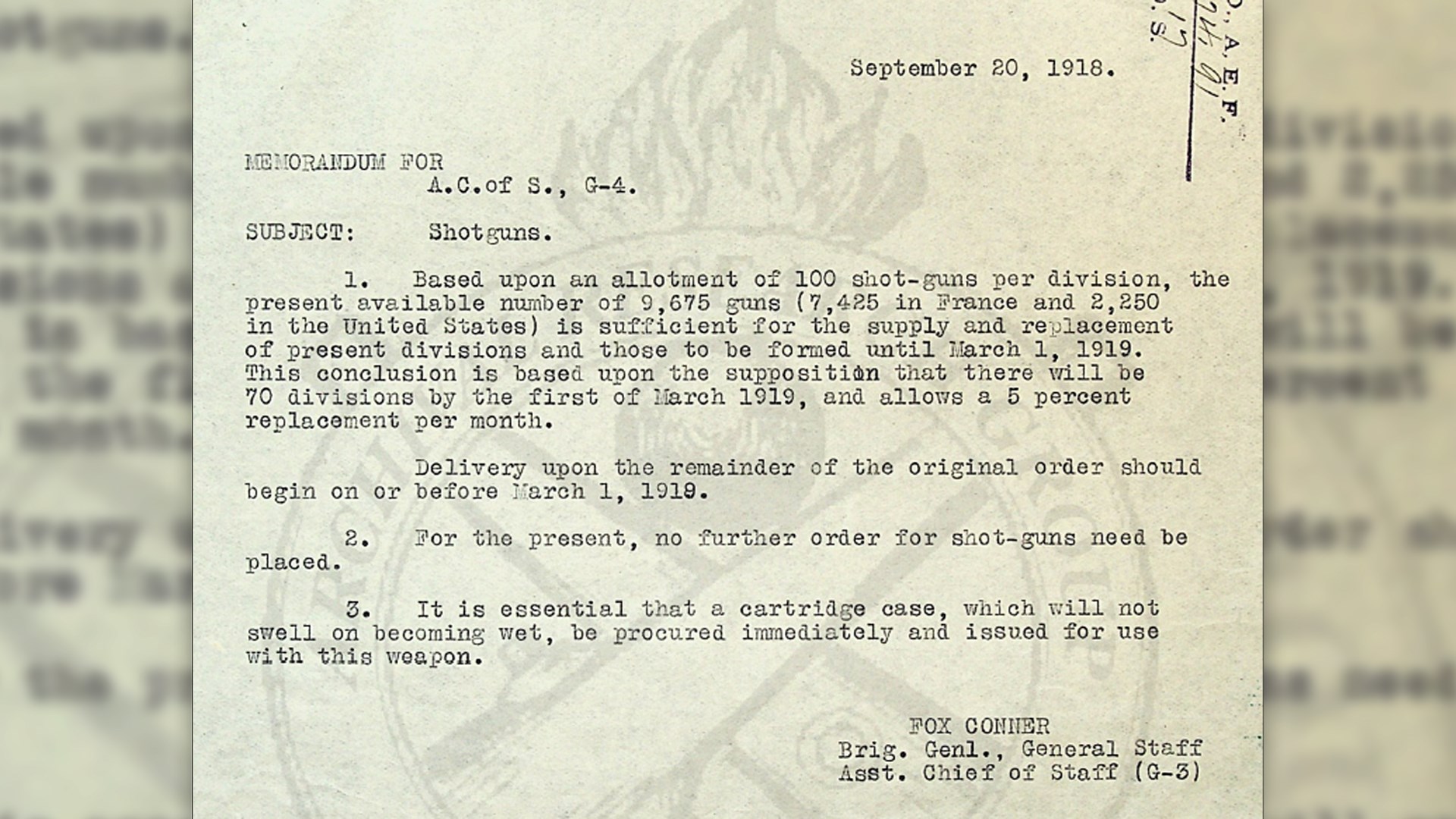 This memorandum between the AEF G-3 (Operations) and G-4 (Logistics) notes the total number of shotguns available in France in September 1918 (7,425), alongside those still stateside, was sufficient to arm all the infantry divisions expected through March 1919. This modest plan, which does not call for additional orders of shotguns from Winchester, belies the great clamor for more shotguns. Document courtesy of Archival Research Group.
This memorandum between the AEF G-3 (Operations) and G-4 (Logistics) notes the total number of shotguns available in France in September 1918 (7,425), alongside those still stateside, was sufficient to arm all the infantry divisions expected through March 1919. This modest plan, which does not call for additional orders of shotguns from Winchester, belies the great clamor for more shotguns. Document courtesy of Archival Research Group.
In June 1918, the AEF Ordnance Dept. wrote to the G-3 requesting guidance on how 1,000 shotguns with ammunition should be distributed. They suggested that “they may prove a most valuable arm for the use of raiding parties, and that a practical test be made […] and that the full information be furnished [to] this office within 30 days …” and that fifty guns should be provided to each test division, with 100 rounds of ammunition per gun.
Just like Fox Conner, they indicated that these should not be personal or individual arms, writing “Insamuch as this weapon is an emergency arm, it is feared that proper care would not be given it, if it was allowed to remain with the troops. For this reason, it is recommended these arms be under the control of the Divisional Ordnance Officer, to be issued by him for use, as conditions warrant.”
In late June and early July 1918, the Services of Supply, the support chain for the AEF, effectuated the official transfer of bayonet-capable riot guns to five divisions for testing in the field. The 5th, 32nd, 35th and 82nd all received 50 shotguns, while the 77th received between 100 and 150 for use. The 32nd Division received the following instruction from the AEF’s chief ordnance officer:
“Since the object of this test is to ascertain the utility and effectiveness of this weapon in both offensive and defensive trench warfare, the Commanding General of your division has been directed to render a report to G.H.Q. on the above points immediately after the operation in which the shotguns have been used. […] It is requested that a report be rendered to this office showing the difficulties experienced in maintenance and the succeptibility (sic) to jam under trench conditions.”
Feedback From The Field
Contrary to the myth, the feedback from the troops in the field was not universal rabid acclaim for the new military arm. Instead, it ran the gamut from overall dislike, conditional favor for special purposes, all the way through to a great love of the shotgun in combat.
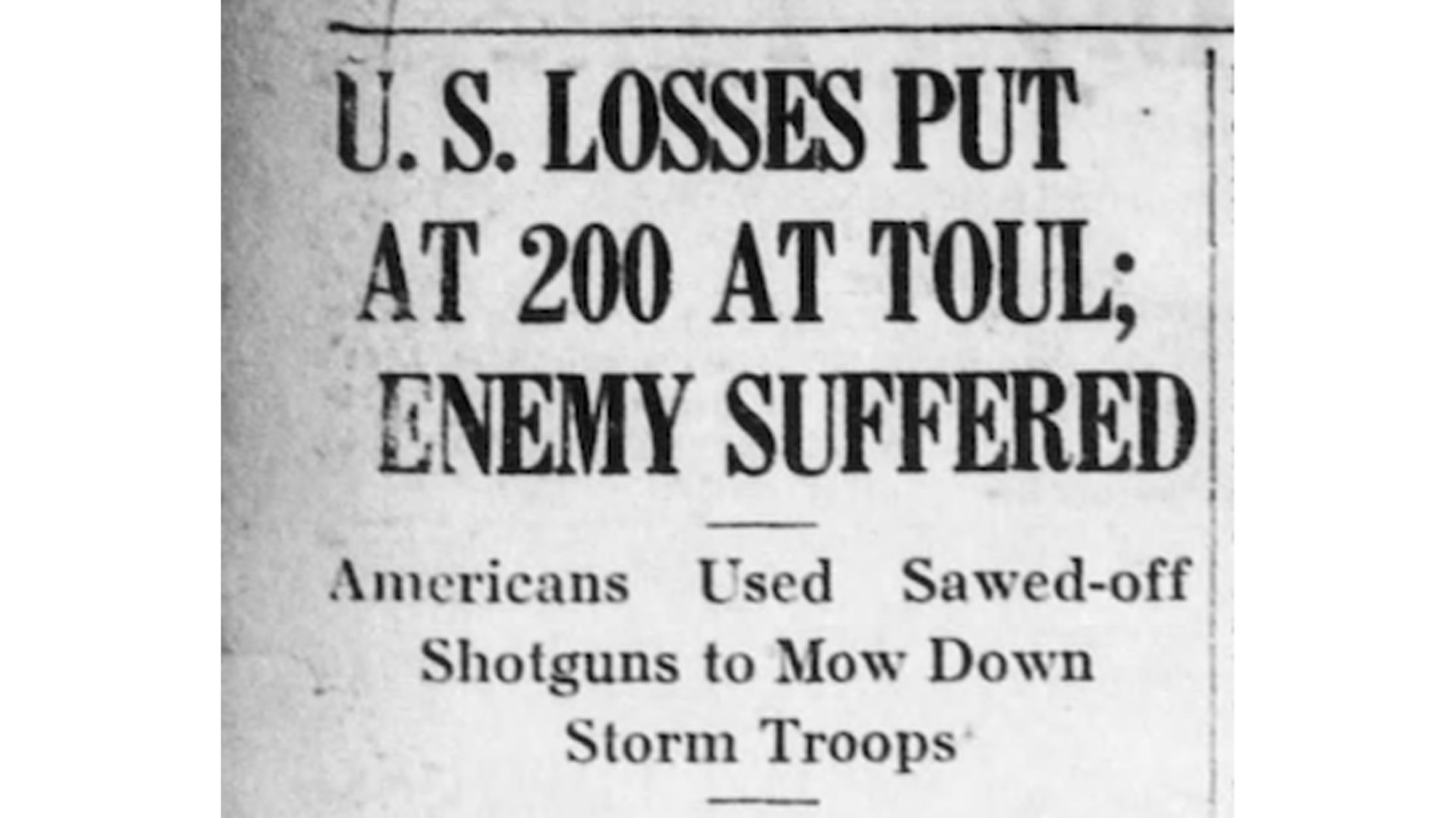 The U.S. press claimed that shotguns had been successfully used in combat as early as April 1918, more than two months before the official combat trials took place. There appears to be no official record of this event.
The U.S. press claimed that shotguns had been successfully used in combat as early as April 1918, more than two months before the official combat trials took place. There appears to be no official record of this event.
On the negative side, the 32nd Division, who became noted as “Les Terribles” for their bravery in the face of brutal street fighting during the time of the field trial, noted that they “do not care for any more of them at present” after recounting their experience fielding shotguns with the scouts of the 127th and 128th Infantry Regiments.
In the 127th, they noted that “the guns were used but little” and the “men did not like them, preferring a rifle.” While acknowledging their usefulness in close fighting, they determined that the shotgun was not suited “to the open warfare in open country” in which they were engaged, with five of the 12 shotguns being lost and the paper shells causing them significant difficulty. The field tests in the 128th Infantry reaped a bloody toll, with reports stating that “all twelve men having these guns were killed or wounded. […] The men much prefer the rifle,” although also noting that “The gun is a fine weapon and might be useful for close fighting.”
In the middle ground, supporting use for a specific purpose but finding them unsuitable for their current reality, were the 35th and 77th Divisions. Both units found shotguns useful for in trench fighting but not for the open warfare expected across the front. An Oct. 15, 1918, a summary of the feedback was compiled by the chief of ordnance of the 1st American Army.
The 35th Division reported that shotguns, “On account of the short range, not adapted for open warfare, except in very special cases. Valuable in trench warefare (sic). Would recommend issue of 50 per regiment [100 per division], which would allow three for each combat group actually at the front.” The 77th Division reported that shotguns were, “Advantageous for trench warfare, but an unnecessary burden for open warfare.”
On the positive side, two units found them effective outside of the trenches as well as in. The 82nd Division recounted that they were “valuable for patrol work” and recommended that 200 be issued per division. The most effusive praise was given by the 5th Infantry Division, however, who reported that the shotguns were “very useful in trench warfare, for scouting and patrol parties and for mopping up.”
While noting the swelling of the paper shells, the 82nd recommended an “issue of 400 per division; eight for each lettered company and four for each Headquarters Company.” In particular, multiple units described the effectiveness of the shotgun during night operations conducted by patrols, where the short range was much less of a liability.
On Sept. 1, 1918, the 5th Division’s 11th Regiment reported that their Scout Platoon commanders reported the following:
- Burst satisfactory
- Dangerous weapon to enemy
- Undoubtedly the weapon for short range patrol work
- Effect on enemy demoralizing
- Effications (sic) in breaking up small parties or patrols of the enemy
- No jamming or “Sticking” of shells reported. Period of trial was during dry weather. Generally recommended for short range night work, both in attack and defense and in patrolling. Adoption Recommended[.]
In total, the overall reports from the combat trials were good, but not great. With the exception of the 5th and 82nd Divisions, who were clear in their praise, the other three units were decidedly more lukewarm on the use of the shotgun in future fighting. These conclusions, drawn directly from official reports from the field, counter the story that there was a universal clamor for “trench guns” from every unit lucky enough to get their hands on some. As usual, the truth is much more nuanced. Given the right conditions and deployment, the shotgun was a fearsome tool in specific circumstances but not universally useful across the entire American sector of the front.
Review & Recommendations
On Sept. 15, 1918, now Brig. Gen. Fox Conner (AEF assistant chief of staff for operations) wrote to his counterpart for supply and logistics, Brig. Gen. Van Horn Mosely (assistant chief of staff for logistics—also closely linked to Gen. Pershing), on how shotguns were to be used by troops in the field. He stated, “The Winchester Repeating Shot Guns are to be adopted as a weapon for defensive trench warfare” and that “the production should be based on an estimate of 100 per division.”
He was apparently quite swayed by the praise from the 11th Regiment, as he adopted most of their bullet points listed above, although noting that the paper shells were unsatisfactory and should be replaced by brass since “Even with the greatest care the shells are likely to become more or less wet when carried by men who have to crawl thru wet grass or remain for some time in the rain.”
That is not to say the acclaim was universal from the top, either, as Brig. Gen. Fiske, writing to the chief ordnance officer, “Recommend[ed] that no issue of shot guns be made to our troops. The narrow and restricted use to be made of them, i.e. certain small phases of trench combat, will not compensate for the necessary increase in our armament supply resulting from their issue.”
And the matter of paper shells highlighted by Brig. Gen. Conner was no small trifling annoyance either. As documents indicate these were to be issued as special equipment, divided out as the situation dictated, Doughboys would be expected to be frequently loading, unloading and otherwise handling the shells, with the issue made worse by a lack of any formal way to carry them. Roughly handled shells, or those stuffed into a fully loaded magazine, were shown to quickly deform. Such a shell might still fit into the magazine tube but jam the action when cycled into the chamber—thus severely limiting any advantage the shotgun might have.
Official Combat Fielding
At this stage in the story, or perhaps after the German protest, depending on the telling, the "trench gun" myth goes that Gen. Pershing shouted from the rooftops “SEND US MORE SHOTGUNS!” In reality, the official decision was closer to: “We’ve got quite enough for the time being, thank you.”
In correspondence between Brig. Gens. Conner and Van Horn Mosely, it is revealed that as of Sept. 17, 1918, the AEF was aware of 9,675 shotguns with bayonet adapters available for use both stateside and abroad. Of these, only 717 were in use by troops on the line, while 6,708 were in depots in France, and 2,250 were on hand in the U.S.
Even this small number was deemed perfectly satisfactory through March 1919 by G.H.Q., as the allotment of shotguns was to be 100 per division. This would allow all 70 of the templated divisions to have their fair share, while also accounting for a five percent replacement rate per month. Important to note is how large the American divisions of the era were, containing approximately 28,000 men and dwarfing the divisions of our European allies. While this necessarily included support troops, artillerymen and others not detailed to carry long arms, it does help indicate how relatively sparse the planned allotment of shotguns was.
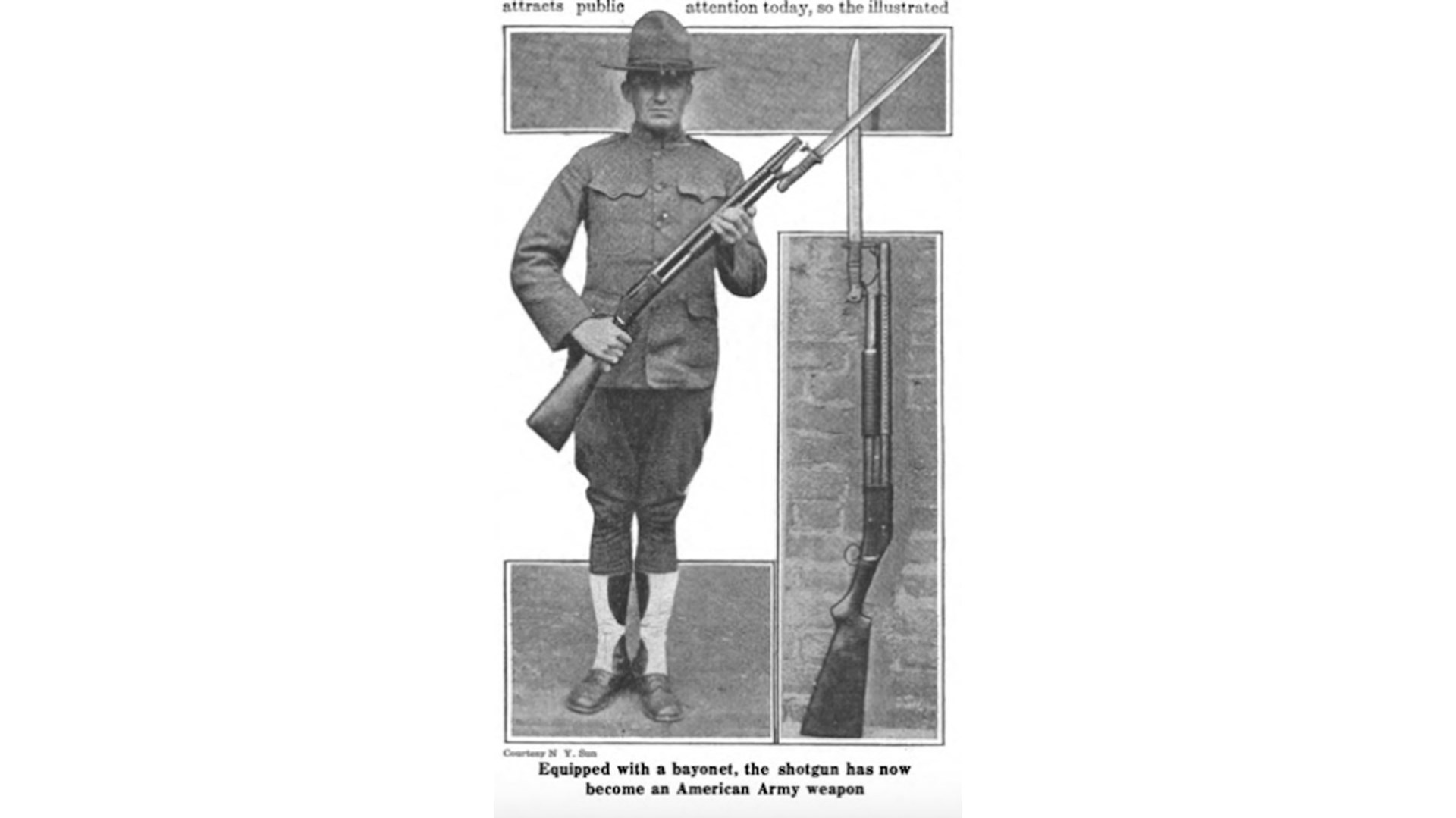 In the spring of 1918, the American press began running stories about the adoption of riot guns with bayonet adapters. This publicity photo (above), published in May 1918 by the Scientific American, shows a likely stateside soldier holding an M1897 Winchester riot gun with bayonet at port arms.
In the spring of 1918, the American press began running stories about the adoption of riot guns with bayonet adapters. This publicity photo (above), published in May 1918 by the Scientific American, shows a likely stateside soldier holding an M1897 Winchester riot gun with bayonet at port arms.
We know shotguns made it to the front with other divisions of the AEF because stories, both official and anecdotal, record their usage in combat. Notably Sgt. Lloyd Seibert, of the 91st “Wild West” Division, received the Medal of Honor for successfully charging a machine-gun emplacement and using his shotgun to kill an enemy soldier. While they certainly proved effective in specific battlefield circumstances, they remained an overall limited-in-numbers specialty arm amongst the ever-growing numbers of the AEF.
So instead of clamoring for more shotguns, or surging those available to the front for the upcoming offensive, the AEF staff was instead making modest plans to supply all divisions with the relatively small number of shotguns already available to them. In fact, while Brig. Gen. Conner did indicate that he wanted the entirety of the original order eventually delivered, he also remarked that, “for the present, no further order for shot-guns need be placed.”
This was likely informed by Van Horn Mosely who cautioned that “While approximately 22,000 additional [shotguns] are under procurement, the production will be delayed unless shotguns are given priority, which of course would seriously interfere with the production of other types of small arms.” This pragmatism reflects the fact that the Great War battlefield was one dominated by artillery and the machine gun, with any realistic impact of the shotgun falling far behind that of even the humble rifleman in many battlefield situations.
Sensational Journalism
Stories of shotguns being used by the AEF began to surface in April 1918, specifically after the battle of Seicheprey on April 20, 1918. Seicheprey was one of the first significant engagements between German and American troops, and it ultimately was one where both sides could claim victory. German shock troops, following closely behind a rolling barrage, assaulted the American positions in the early morning of April 20, catching the Americans off-guard in what was supposed to be a quiet sector of the line. In the ensuing chaos, the AEF would initially withdraw from the area, regroup and counterattack their former positions, retaking the ground they had temporarily lost.
It was a victory from the American perspective because no ground was ultimately ceded to enemy forces. However, Germans could claim the victory that had achieved their goals of gathering intel on their newly arrived enemy forces, taking some prisoners and successfully withdrawing from the field. However, the true lasting victor would be created not by the muzzle end of a rifle, but by the ink of a printing press.
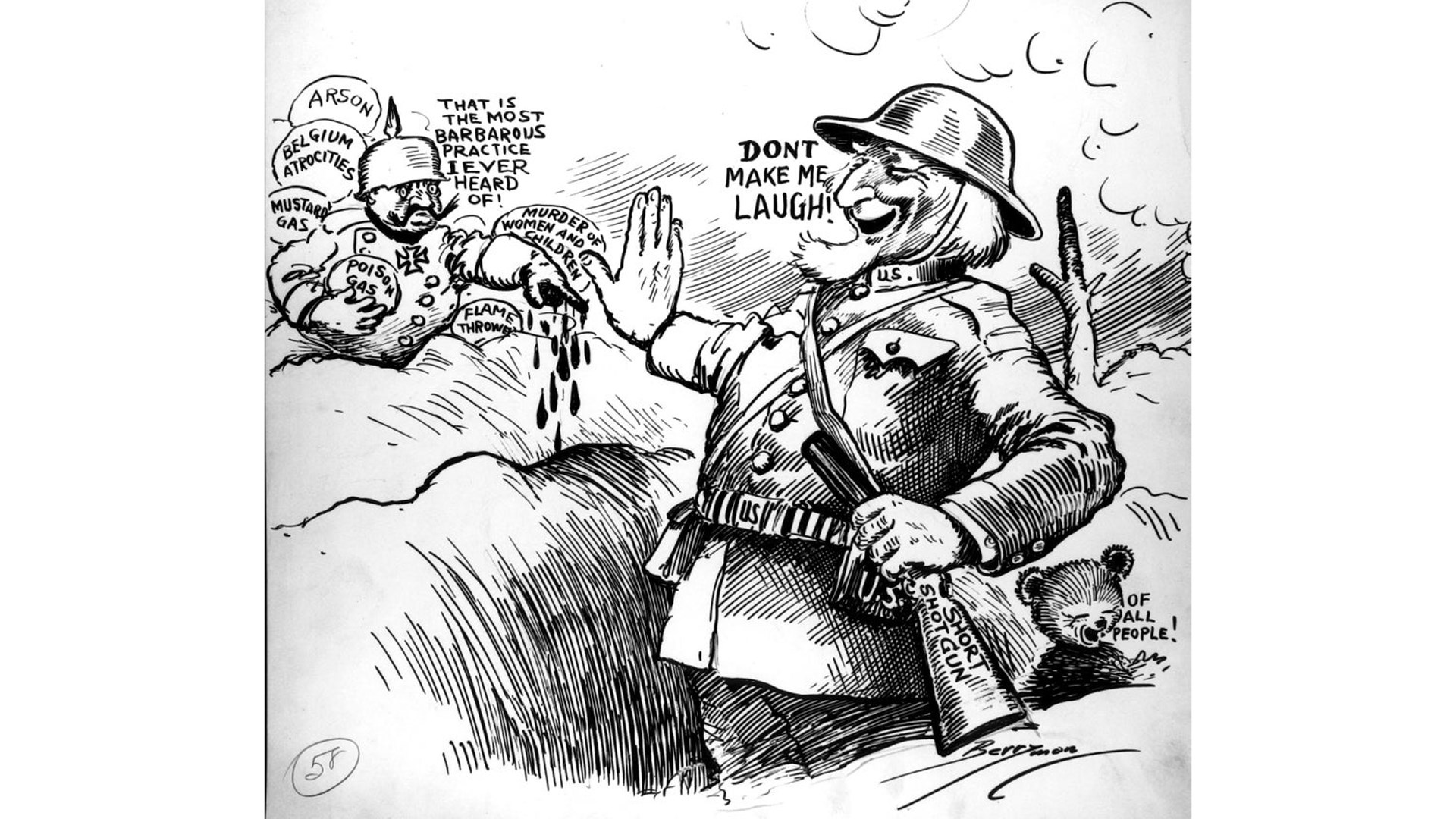 The American public generally regarded the German protest on the use of shotguns to be absurd hypocrisy, with this cartoonist capturing the mood quite cleverly. In the drawing, Uncle Sam is lucky enough to have a cartridge belt for his shotshells, something the Doughboys unfortunately did not receive.
The American public generally regarded the German protest on the use of shotguns to be absurd hypocrisy, with this cartoonist capturing the mood quite cleverly. In the drawing, Uncle Sam is lucky enough to have a cartridge belt for his shotshells, something the Doughboys unfortunately did not receive.
The newspapers back in America began to run with the story that the Americans had fielded shotguns to deliver a decisive blow to the Germans.
On April 23, 1918, The New York Herald reported:
"Pershing's Men Used Sawed Off Shotguns to Mow Down Storm Troopers."
"Americans Put Up Desperate Resistance of the Village of Seicheprey."
On April 28, 1918, The Harrisburg Telegraph reported:
"Losses Put 200 at Toul; Enemy Suffered."
"Americans Use Sawed-Off Shotguns to Mow Down Storm Troopers."
Given that the battle predates the combat field trials of shotguns by approximately two months, and no earlier official mention of AEF shotgun use has been found, these reports are likely complete fabrications or misunderstandings. However, the story gained momentum and evolved. By May 1918, newspapers and magazines were reporting that shotguns could be used to "bag" grenades and the Army would employ trapshooters to help explode "Hun" bombs.” These stories even likely influenced stateside military officers, with the Army’s acting judge advocate general incorporating grenade and carrier-pigeon shooting as secondary purposes for the shotgun in combat.
Clearly, the story was larger-than-life and getting out of control. The chief of ordnance Gen. Crozier was surprised when inquiring letters began coming into his office, with the official reply being, "These guns were bought to guard prisoners. The Ordnance Department is not officially advised that they have been used or will be used for any other purpose.” Combat field trials for such shotguns were still yet to occur.
However, that did not matter because every major newspaper told the public that the Americans were bringing something uniquely American to the battlefield. The journalists at home used this as a chance to push "American exceptionalism" in a European war that had been going on for several years. This belief that shotguns were used effectively and that there was no corroboration from primary sources within the Army Ordnance files is one of the more effective propaganda campaigns, because it still lingers today.
The German Protest—War & Politics Forever Intertwined
Much emphasis is placed on the German protest, forwarded through the Swiss Legation in Washington, D.C. regarding the American use of shotguns in combat during the summer of 1918. And the complaint itself is certainly an attention-grabber. It accuses the United States of using “especially forbidden” methods of warfare—specifically arms or projectiles “calculated to cause unnecessary suffering.” It also threatens death to any Doughboy caught with either shotgun or shotshells in their possession.
The popular narrative of the protest itself runs parallel to the tales of the shotgun effectiveness and goes as follows: The Germans were so shocked and horrified by the brutal close-range effectiveness of the unique, powerful and quick-firing shotguns that they immediately took extraordinary steps to try and remove it from the battlefield while, concurrently, Gen. Pershing (with the backing of the Army judge advocate general, secretary of war and secretary of state) hollered for more of these potentially war-winning firearms.
Upon review of the facts regarding the American fielding of shotguns, that does not appear to be the case. The Germans were instead likely engaging in the time-honored, and very German, tradition of blending war with politics and trying to score a diplomatic and propaganda victory, as opposed to reacting in genuine shock to the tactical battlefield implications of a new limited-issue gun. This is supported by the fact that the Germans had filed their first protest regarding shotguns (and specifically Winchester Model 1897s, to boot) in December 1914, well before the American entry into the war.
During World War I, there were many protests, filed by many different nations, hurling allegations with differing degrees of merit back and forth. The famed shotgun protest is often talked of singularly, as if it were some uncommon event, but in truth, it was one of many similar communications. These tools of political warfare, while ostensibly designed to address tangible issues of state concern, also allowed nations to advocate for their beliefs, jockey for public support and sympathy and vilify their enemies. It is critical to remember that context and give the appropriate weight to the shotgun complaint in light of it.
The First German Protest—December 1914
Long before any shotgun-armed Doughboy was on the fields of France, and sandwiched between concerns of "dum-dum" and mushrooming bullets, the German Ambassador to the U.S. wrote:
“It has come to the knowledge of the German Government that the British Government has ordered from the Winchester Repeating Arms Company 20,000 “riot guns”, Model 1897, and, 50,000,000 “buckshot cartridges” for the same. The buckshot cartridge contains nine shots. The use of this weapon and ammunition is as yet unknown to civilized warfare.”
He further stated that the magnitude of the order indicated the British intention to use it in Europe, that these methods of war “[set] every rule of international law at defiance …” and complained that the U.S. supplying ammunition to be used contrary to international law, of which the U.S. was a signatory, was not “within the spirit of neutrality.”
One cannot be sure where the German ambassador got his information, although German spies were certainly present in U.S. industry, but the order or sale of shotguns or shotshells was “categorically denied” by Winchester and was communicated via both publication and the secretary of state, although they wisely did not communicate any position or opinion on the lawfulness of the shotgun in combat.
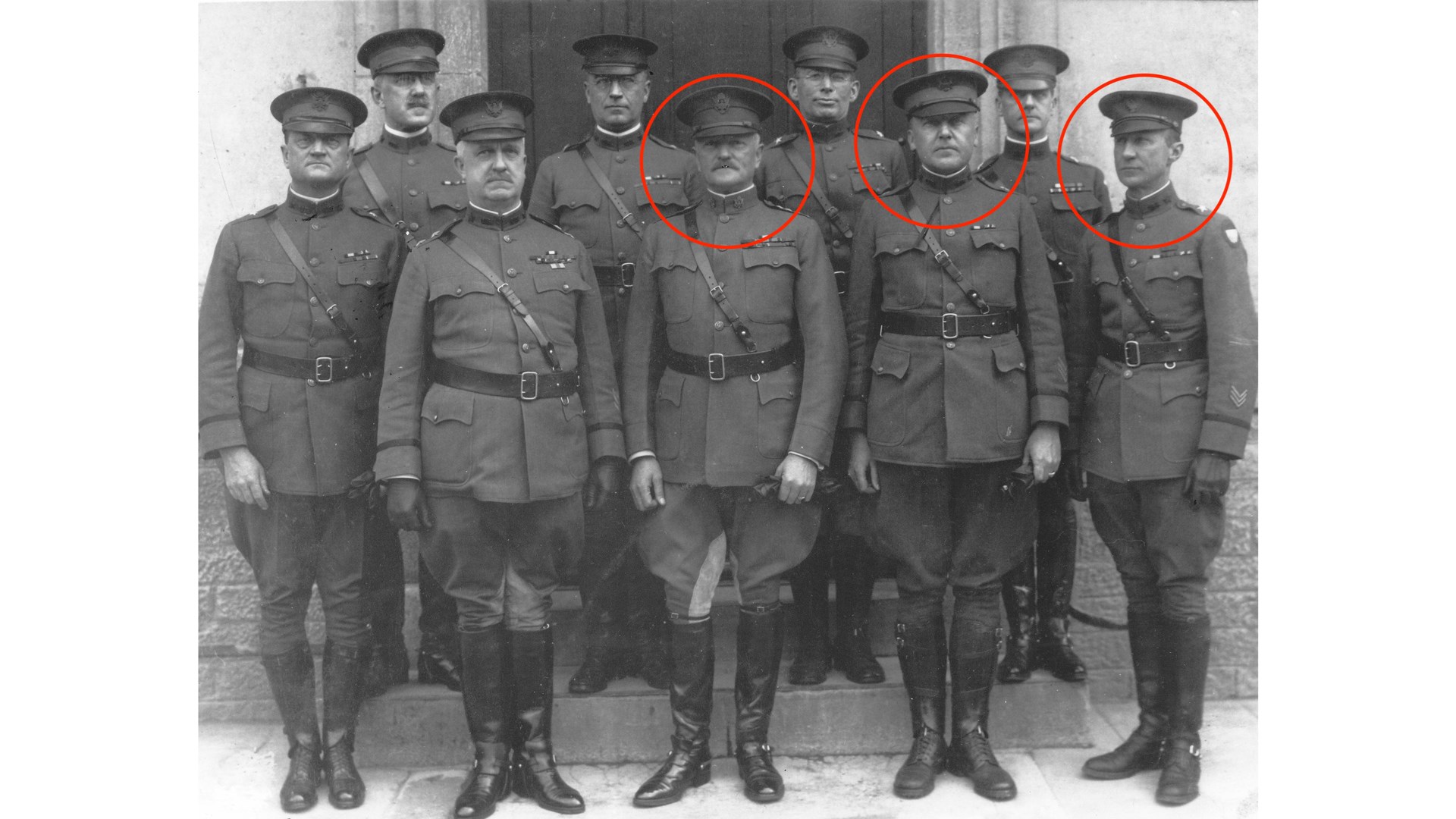 The three circled men had significant influence in fielding riot guns with bayonet adapters in combat. Commander of the AEF Gen. Pershing (l.) requested the initial adoption of a bayonet-capable shotgun. Assistant Chief of Staff for Operations Brig. Gen. Fox Conner (center), helped establish the combat trials and supported the adoption of shotguns for trench warfare. Assistant Chief of Staff for Logistics Brig. Gen. George Van Horn Moseley (r.) worked to get the shotguns in the hands of the Doughboys of combat divisions.
The three circled men had significant influence in fielding riot guns with bayonet adapters in combat. Commander of the AEF Gen. Pershing (l.) requested the initial adoption of a bayonet-capable shotgun. Assistant Chief of Staff for Operations Brig. Gen. Fox Conner (center), helped establish the combat trials and supported the adoption of shotguns for trench warfare. Assistant Chief of Staff for Logistics Brig. Gen. George Van Horn Moseley (r.) worked to get the shotguns in the hands of the Doughboys of combat divisions.
The 1914 complaint, lodged about the theoretical possibility of shotguns on the battlefield at some point in the future, cuts against the theory that the well-known late-war protest was made primarily due to their effectiveness in the hands of daring Doughboys slam-firing into trenches. It is actually possible that the Germans had some true plausible hypothetical reservations about the lawfulness of shotguns as a weapon of war, especially given the inclusion of the protest amongst claims of "dum-dum" bullets (specifically outlawed by international agreement) and expanding mushrooming (which were new at the time and subject to intense debate during the 20th and 21st centuries), as dissonant as that might be given their soon-thereafter use of poison gas and flamethrowers in 1915.
Did The Germans Protest Because The Shotgun Was Just Too Good?
Looking back on the war more than 100 years later, and knowing the conduct of German forces during that time, their concern about the lawfulness of shotguns seems positively absurd in light of their infamous use of gas and flamethrowers. But if the Germans were ultimately willing to use such tools of war starting in 1915, why did they not also employ the shotgun in their armed forces? The answer appears simple: They likely did not see it as battlefield tool of significant worth that needed to be fielded alongside their machine guns, rifles and submachine guns. Otherwise, they likely would certainly have found a way to circumvent any moral reservations they may have had regarding shotguns, as they did with gas.
It is also doubtful that their limited interaction with shotgun-armed American troops in the field prior to the September 1918 protest, as detailed earlier in this article, dramatically changed their minds on that point. According to their own records, German troops encountered shotguns only on a limited number of occasions and, instead, it appears that most of their information on the American use of shotguns came from the breathless, and often wildly inaccurate, reporting in the American press. The capture of a handful of shotgun-armed troops in the field then simply confirmed these news reports to them.
So why would the Germans send the protest if they were not terrified of the tactical effects of the shotgun on their war plans? Perhaps because of the propaganda value of painting the newly at-the-front Americans as barbarous savages. Even if they did have some lingering lawfulness concerns about shotgun use, the actual outcome of the complaint was largely irrelevant.
The First World War was a propagandist’s playground, and the Germans were very often on the back foot. Images of blood-soaked German soldiers leering at the viewer, shadowy pickelhaube-wearing figures menacing innocent women and children, and hulking (similarly pickelhaube-wearing) apes wielding “KULTUR” clubs were dominant images. Likewise, stories of German atrocities were blared on headlines, whether or not they were thoroughly fact-checked.
The shotgun controversy was a chance for the Germans to strike back against this image and paint someone else as “the other” in an effort better their post-war political position and bolster public support at home. While active hostilities on the battlefield ended in November 1918, the political fight soldiered on until June 1919, ending only with the signing of the Treaty of Versailles.
While the Germans making the protest certainly could not have predicted the specific outcome of the war, the tide had turned against Germany by the fall of 1918, and German leaders were likely continuing to shape the political battlefield of their future. Taking a shot at the newest—and decidedly foreign—nation involved may have been an attempt to gain some rhetorical "what-about-ism" ammunition for legal and political reasons.
 This side profile of an M1897 Winchester riot gun with bayonet adapter shows the typical WWI features: High comb stock, 29 hole-per-row heat shield and clamp-on bayonet adapter. Document courtesy of Archival Research Group.
This side profile of an M1897 Winchester riot gun with bayonet adapter shows the typical WWI features: High comb stock, 29 hole-per-row heat shield and clamp-on bayonet adapter. Document courtesy of Archival Research Group.
And the narrative was pretty simple: Instead of honorably fighting as we Europeans had been, these barbarous cowboys from across the sea are wrongfully and savagely using small arms banned by international accord. On the German home front, as reported by the New York Times, German newspapers in July 1918 (notably before the capture of the shotgun-armed men from the 77th Division) denounced “America’s barbarism and assumes that tomahawks and scalping knives will soon appear on the American front” and that the Americans are issuing shotguns “not because they are likely to be effective, but because the ill-trained Americans cannot use rifles and are badly supplied with machine guns.”
If propaganda was indeed the main aim, the ultimate fate of shotguns on the battlefields of the western front was almost irrelevant since the goal was drawing attention to the alleged outrage, not any legal or practical outcome. So, while the Army’s acting judge advocate general wrote a legally sound opinion that supported the lawful use of shotguns, and which is still cited favorably by senior officers in the modern JAG Corps, that opinion has undoubtedly had more tangible impact on the 100+ years that followed the First World War than it did on the war during which it was drafted.
Conclusion
Riot shotguns with bayonet adapters certainly played an important role. While the earlier military usage of shotguns had been small-scale or ad-hoc, World War I saw the development of specialized military variants, comparatively larger purchases and deliberate combat field trials. But ultimately, their impact was much more significant post-World War I than during the conflict itself, as their fielding set the stage for shotguns to become a standardized and significant piece of military equipment, even into the modern day.
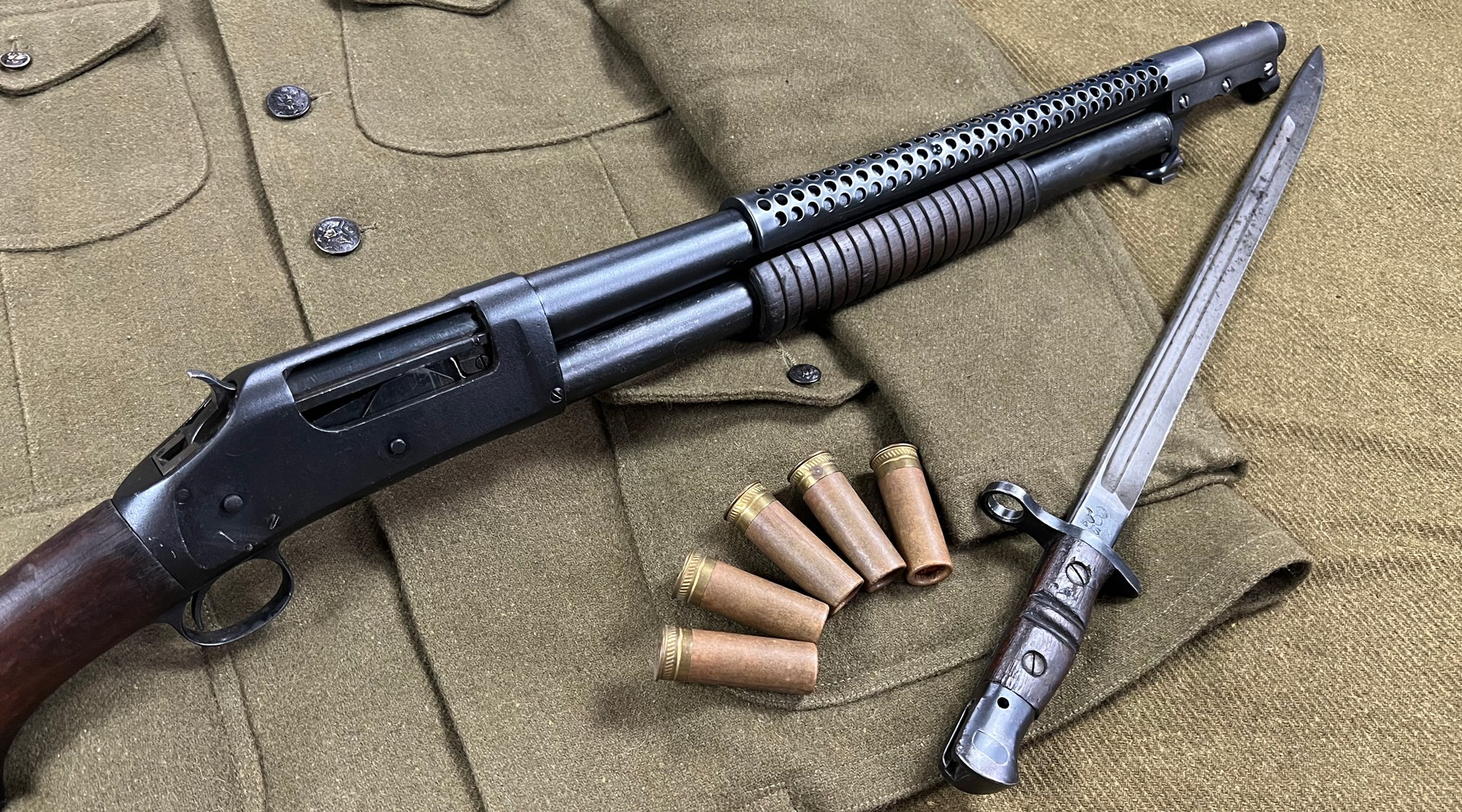
As shown by official documentation, their combat use was relatively limited during the conduct of the war, with their primary purpose being to guard the German prisoners expected following the transition to open warfare. As of mid-September 1918, only 717 shotguns were recorded as being “on the line,” and AEF plans only called for 100 shotguns to be issued per 28,000-man strong division through March 1919. While many of these saw combat during the hard fighting in the final months of the war, they made up an incredibly tiny amount of the small arms available to the AEF.
Added to that, as reported by many of the troops who participated in the combat trials, they were often not suited for the tactical tasks demanded of the units who carried them, made even worse by the fact that suitable ammunition was never fielded during the course of the Great War. The subsequent 100+ years has of course shown them to be an incredibly capable military arm—but only when employed in specific circumstances which support their use.
But if anyone won the propaganda war in the long run, it was certainly the “trench gun.” Through a combination of sensational period media (both stateside and abroad), German protests and downright fearsome looks, it has successfully cemented itself as an instantly recognizable and terrifying icon of the Great War.













